176 Search Results for prompt
November 10, 2022
by Carole Zangari -
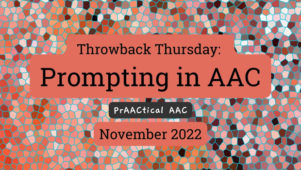
It gets a bad rap but when used thoughtfully, this powerful tool can be a game-changer. Today, we’re talking about the pitfalls and promises of prompting. Take a look. When Helping Isn’t Helping-Prompt Awareness in AAC Instruction Building AAC Facilitation Skills with Tabi Jones-Wohleber: MASTER PAL Training, Module 10 (Appropriate Prompting) 5 Things to Consider About Prompts in Teaching AAC Reducing Prompt Dependence in AAC Learners: 5 Things to Try
October 25, 2018
by Carole Zangari -
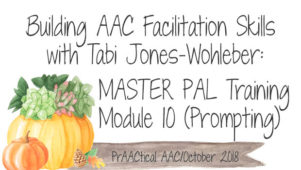
The right types of prompts delivered at the right time in the right amount can be enormously powerful in supporting AAC learners. On the other hand, the wrong type of prompt or prompts that offer too much or too little help can impede learning, self-confidence, and cause other problems as well. In today’s continuation of the Model as a MASTER PAL Training Series, Tabi Jones-Wohleber addresses issues related to prompting. As with the other modules, she provides slides, handouts, video links, discussion points and more. This module should take about 30-40 minutes to present. Looking for the earlier modules in the MASTER PAL Series? Check them out here. :::::::::::::::::::::::::::::::::::::::::::::::::::::::::::::::::::::::::::::::::::::::::::::::::::::::::::::::::::::::::::::::::::: Model as a MASTER PAL Module 10: Appropriate Prompting Facilitator Guidelines What it comes to prompting, it’s important to get it right! Inappropriate prompting can result in decreased quality interactions characterized by prompt dependence, passive engagement, and of course poor use of... [Read More...]
July 26, 2017
by Carole Zangari -
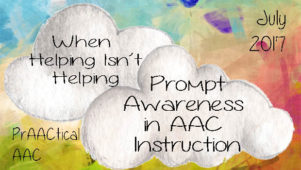
Learning to communicate with AAC can be a long road with plenty of twists and turns. In most cases, AAC learners require support and that may include various forms of prompting. In today’s video, we feature a presentation from the AAC in the Cloud Conference that CoughDrop hosted last month. In this video, SLP Rachael Langley, shares her thoughts on prompting, where we go wrong, and how we can use it to better support AAC learners. Many thanks to CoughDrop and to Rachael Langley for making this presentation available. Direct Link to Video: https://www.youtube.com/watch?v=B2mtuhVa0WA&index=3&list=PL8oiM_hsU8kYofdlpC4vcYX49yuBZvv9v
January 26, 2017
by Carole Zangari -
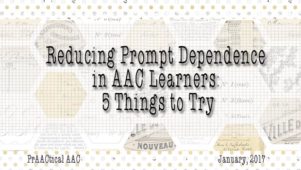
“He knows what to do. He just doesn’t do it.” “He’s prompt-dependent. How can I get him to use AAC on his own?” “I love his strong-willed nature, but it works against him sometimes. He doesn’t initiate.” If any of these remarks sound familiar, it may be time to think about alternative approaches to build independent communication. Here are a few things to try with AAC users who’ve learned to wait for support before communicating. Exaggerate the pause time: Many of our AAC learners need at least 5 seconds of pause time after a communication opportunity presents itself. This helps them process the experience, organize their thoughts, decide on a response, and then begin to execute that response. Sometimes, though, we work with people who’ve learned that if they just wait, the communication partner will start to help (whether or not they need it). We can sometimes nudge the learner... [Read More...]
September 16, 2013
by Carole Zangari -
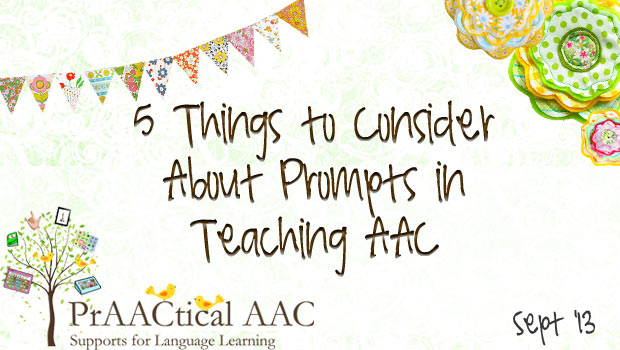
When you’re learning something new, it’s likely that you’ll need some help along the way. The same is true for our AAC learners. Here are some of the things we’ve been thinking about lately regarding prompts and cues. 1. Sometimes, actually MANY times, a ‘perfect pause’ is all that’s needed. Stop the action, look expectantly at the learner, and wait quietly. How long? It depends on the individual and the situation, but 10 or 15 seconds is in the ballpark for most AAC learners. 2. It’s important to consider both the type of prompt (e,g., gestural, verbal, physical) and how much information that prompt provides to the learner. We hear lots of SLPs say that they prefer verbal prompts because they are less helpful than, say a physical prompt, and, thus, require more from learner. Not always. Here’s an example: “Jason, tell me, ‘More milk.’” Vs. Gesturing over the message... [Read More...]
April 13, 2025
by Carole Zangari -
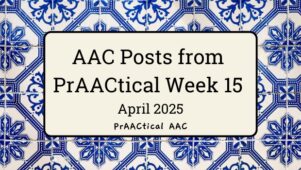
Happy Sunday, AAC friends. We have some posts you might enjoy. Tuesday – AAC Link Up Wednesday – Video of the Week: AAC Tools Explained by Those Who Use Them Thursday – Resource Roundup: AAC-friendly Earth Day Materials Also, if autism is an area of interest, consider joining us at this free webinar by Dr. Petere Vermeulen on Autism & Happiness: From Neurodiversity to Neuroharmony (registration link here). :::::::::::::::::::::::::::::::::::::::::::::::::::::::::::::::::::::::::::::::::::::::::::::::::::::::::::::::::::::::::::::: Have time for a little more browsing? Check out these past posts. When Helping Isn’t Helping-Prompt Awareness in AAC Instruction Administratively Speaking: 5 Considerations for Recruiting and Retaining AAC SLPs AAC In the Classroom: Considerations for Modeling Core Vocabulary How I Do It: A Year of Core Word in Action AAC in the High School Classroom: Where Core Vocabulary Meets Life Skills
January 5, 2025
by Carole Zangari -
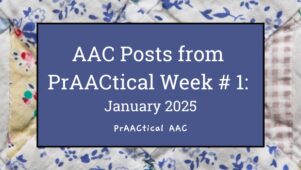
Happy New Year, AAC friends. We have a few posts to help you start 2025 with a touch of AAC. Monday – PrAACtically Energized: Ideas for Boosting AAC in the New Year Tuesday – AAC Link Up Wednesday – Top Videos of the Year – 2024 Thursday – After the Holidays: AAC Conversations Using Pre-stored Questions Friday – PráctiCAAmente Conectados: Comunicación sin Barreras :::::::::::::::::::::::::::::::::::::::::::::::::::::::::::::::::::::::::::::::::::::::::::::::::::::::::::::: Ready for a few more suggestions? Here are some past posts that you might enjoy. PrAACtical Ideas for Repurposing Older AAC Technology 5 AAC Downloads to Use and Share 5 Ways to Make Semantic Maps More Effective in AAC Therapy PrAACtical Resources on Language Development When Helping Isn’t Helping: Prompt Awareness in AAC Instruction
December 11, 2023
by Carole Zangari -
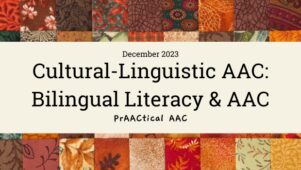
Our yearlong series on multilingual AAC support, guest-authored by BilingüeAAC, is drawing to a close. In today’s post, Melissa Tapia and Sarah Lee address AAC, bilingualism, and literacy. BilingüeAAC is a group of SLPs with a shared belief in providing evidence-based intervention strategies and resources to bilingual Spanish AAC clients, families, caregivers, and professionals. ::::::::::::::::::::::::::::::::::::::::::::::::::::::::::::::::::::::::::::::::::::::::::::::::::::::: Bilingual Literacy & AAC Welcome back to our Bilingue AAC Series! You can find our previous posts linked here, which wonderfully highlight best practices in bilingualism and AAC. (Post 1, Post 2, Post 3, Post 4, Post 5). We are excited to dive into our topic of bilingualism, literacy, and AAC and how we can effectively provide literacy intervention in culturally affirming ways with our Bilingual* AAC users. *Clarification: We address “bilingual populations”; however, the resources discussed are specifically for Spanish/English speaking populations. Several of the suggestions can be broadly applied to other languages. The goal... [Read More...]
September 16, 2023
by Carole Zangari -
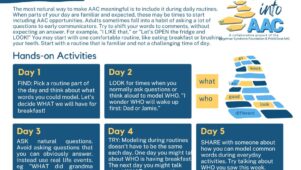
About This Week Welcome to Week 10 of your Stepping into AAC journey! This week, we continue to explore ways to fit AAC support into daily life. You will explore the following concepts this week: Making Space for AAC: Learn some concrete ways to infuse AAC support into conversations, activities, and routines. Getting Dressed with AAC: Look at how AAC can be infused into a simple daily routine as we dive into another language walk-through. Using AAC to Foster Self-determination: Personal autonomy is a key ingredient in a rich and fulfilling life. Explore the role that AAC can play in empowering our learners and facilitating the development of self-determination. More Strategies to Build AAC Use: What is scaffolding, and how can we leverage it to facilitate communication and language learning? AACtion Steps Week 10 AACtion Steps Signposts Get the Handout Make Space for AAC Get the Handout Self-Determination Get the... [Read More...]
September 11, 2023
by Carole Zangari -
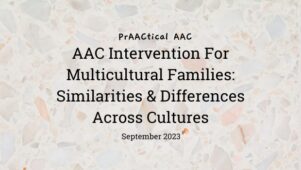
Across the world, AAC teams are looking for ways to strengthen their support of multilingual individuals with complex communication needs. In this article, guest authors Hsiao-Ting Su and Wen-Hsin Ku, who are both bilingual Mandarin-English SLPs, share their thoughts. AAC Intervention for Multicultural Families – Similarities and Differences Across Cultures Though there are limited AAC resources in minority languages at this time, SLPs should make every effort to meet the needs of multicultural families. It is crucial for SLPs to keep cultural differences in mind when working with multicultural families. As two bilingual English-Mandarin-speaking SLPs who have worked with both families in the U.S. and Taiwan, we have first-hand experience navigating similarities and differences across cultures. Here, we describe some of the similarities and differences we have encountered most frequently. Similarities: Families worry that AAC will hinder verbal communication development Families need reassurance that it is okay for children to... [Read More...]









